
Connie Rovina, Tatipai Barsa and Lisa Michl Ko-manggén celebrate a strong Cape and Torres presence at Big Talk One Fire. Photo: Chisa Hasegawa.
From traditional headdresses, dance, paintings and more, the presence of Cape York and Torres Strait cultures continues to strengthen following a popular First Nations art festival in Cairns over the weekend.
The 18th edition of UMI Arts’ Big Talk One Fire festival brought together more Cape and Torres storytellers than ever before, with community members making up a large portion of performers, workshop facilitators and stallholders at Munro Martin Parklands on 13 September.
UMI Arts artistic director Lisa Michl Ko-manggén said the event had become more of a “music festival” in past years, but they chose to curate the lineup differently this year.
“What we’ve done is we’ve taken it back to its roots,” she said.
“The original Big Talk One Fire festival was a coming together of Elders and senior cultural practitioners from regional and remote communities, as well as local artists and families.
“[We are] really going with a more, I guess, culturally authentic experience for visitors … for visitors to Cairns to come along and see dancing they wouldn’t normally see unless they go to, for example, Laura Festival.”
Murray (Mer) Island artist Tatipai Barsa, who presented a series of intricate headdresses, fish traps and artworks, said he hoped the works could keep culture alive by inspiring young people.
He said the headdresses, which took him roughly three to four months to make, were traditionally used for a dance called Kab Kar, but it was not performed often anymore.
“It’s mainly for a lot of young people to come and see, because normally, they see it on the Torres Strait flag, you see the headdress, but to actually see one in person [is different],” he said.
“If I can just get one or two people to take up doing art, that’s what I want to do.”
UMI Arts chair and WidiWorks stallholder Connie Rovina said the growing engagement from young people was one of the event’s highlights.
“We’re really happy that we’ve got younger people coming in, and with that, we get a lot more excitement and a lot more vibrancy,” she said.
“It’s the connection between all of the people, that passing on of culture from the Elders to the younger people, and seeing it just vibrate.”











